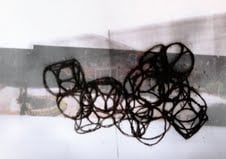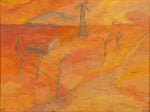Yona Friedman Museum

Yona Friedman Museum è un’architettura, un museo mobile e portatile, che resterà collocato per tre anni nel parco di Villa Sucota, accanto all’edificio principale della Fondazione Antonio Ratti, creando al contempo un ideale prolungamento della struttura ed un nuovo, ulteriore sviluppo delle attività della FAR.
Comunicato stampa
YONA FRIEDMAN MUSEUM
LE MUSÉE DU QUOTIDIEN
un progetto di Jean-Baptiste Decavèle e Yona Friedman
in collaborazione con Nico Dockx
presentazione delle pubblicazioni
Yona Friedman, How to exhibit?
Liliana Moro, Moi
XIX CSAV, The collected work of H.C.
Yona Friedman Museum è un’architettura, un museo mobile e portatile, che resterà collocato per tre anni nel parco di Villa Sucota, accanto all'edificio principale della Fondazione Antonio Ratti, creando al contempo un ideale prolungamento della struttura ed un nuovo, ulteriore sviluppo delle attività della FAR.
Dopo l'esperienza di Friedman come visiting professor del XIV CSAV nel 2008, l'architetto e Annie Ratti hanno avviato uno stimolante dialogo, ancora in corso, il cui primo risultato si concretizza nell’installazione del museo a Villa Sucota. Yona Friedman Museum - Le Musée du Quotidien è un'architettura aperta, interattiva e dinamica, pensata per essere utilizzata da diversi gruppi di persone e in differenti contesti. Nei prossimi tre anni, la struttura ospiterà ed ispirerà una serie di progetti e di attività che ruoteranno attorno al tema “Cosa significa 'esporre'?”. Seguendo la filosofia di Friedman, queste serie d’interazioni ed interventi artistici saranno realizzate trasformando la struttura, per forma e contenuto, a seconda delle necessità, conversazioni ed idee delle persone che prenderanno parte al progetto.
Yona Friedman Museum è la risposta ad una serie di conversazioni e collaborazioni tra numerosi partner: Lorenzo Benedetti (direttore del De Vleeshal, Middelburg), Jean-Baptiste Decavèle, Nico Dockx, Yona Friedman e Annie Ratti.
E’ un work in progress artistico e architettonico, composto mediante ‘improvvisazione’ e applicando le Space-Chain Techniques di Yona Friedman. Il museo è stato realizzato da Jean-Baptiste Decavèle e Nico Dockx in collaborazione con due gruppi di studenti ed ex allievi della Royal Academy of Fine Arts di Anversa, Belgio, e dell'Accademia Aldo Galli di Como. I due gruppi hanno lavorato insieme per una settimana assemblando la struttura del museo mobile, un'Iconostase, composta di 500 anelli in acciaio, di 150 cm di diametro l'uno, collegati tra loro. Seguendo i principi base del museo mobile, gli anelli sono ora al loro terzo assemblaggio. Prima di arrivare a Como, costituivano gli elementi strutturali di Architecture without Building, una mostra a cura di Lorenzo Benedetti tenutasi al De Vleeshal; in seguito hanno viaggiato verso la Royal Academy of Fine Arts di Anversa su invito degli studenti e di Nico Dockx, per diventare Museum without Building.
Il primo appuntamento con questo museo in progress sarà il 30 ottobre alle ore 17. L'inaugurazione di Yona Friedman Museum sarà anche l'occasione per presentare al pubblico tre volumi: il nuovo libro di Yona Friedman, How to exhibit?; l’ultimo libro d’artista prodotto da FAR, Liliana Moro, Moi; e l'esito del XIX CSAV, The collected work of H.C.
Il volume How to exhibit? è una dichiarazione giocosa che descrive le caratteristiche storiche e socio-politiche legate all’idea di Iconostase di Yona Friedman, dalla prima visualizzazione, come disegni, a Parigi nel 1958, alla recentissima installazione della struttura alla FAR. Il libro è uno strumento importante per sviluppare ulteriormente le idee che compongono Yona Friedman Museum, ed è inoltre un invito al lettore/spettatore a rielaborare la propria percezione del museo. Il volume, edito dal De Vleeshal di Middelburg e a cura di Jean-Baptiste Decavèle, Nico Dockx e Yona Friedman, è stato concepito come un Iconobook (un'Iconostase in formato libro), le cui pagine possono essere mescolate e ri-arrangiate dal lettore; sarà presentato da Lorenzo Benedetti.
Il libro di Liliana Moro, dal titolo Moi, riflette su concetti quali libertà, spazio, fragilità, suono, narrazione, interno ed esterno, i temi fondamentali nel lavoro dell'artista durante tutto il corso della sua carriera. Pubblicato da Blackdog (Londra), il volume comprende un contributo di Cecilia Casorati e il testo relativo alla conferenza di Toni Negri tenutasi alla FAR nel 2012, in occasione del XVIII CSAV - Artists Research Laboratory.
The collected work of H.C., pubblicato da Mousse (Milano), rappresenta l'esito del XIX CSAV - Artistis Research Laboratory. Cogliendo lo spirito del workshop condotto nell'estate 2013 da Matt Mullican e utilizzando alcuni elementi del lavoro dell’artista come punto di partenza, i partecipanti CSAV hanno creato un alter ego collettivo, l'artista H.C., le cui opere sono raccolte nella pubblicazione. Il libro, concepito come un lavoro in collaborazione, offre al lettore un overview della pratica artistica di H.C. e molti indizi riguardanti la sua vita privata.
E' possibile scaricare il comunicato stampa su
http://www.fondazioneratti.org/pressKit/49/yona_friedman_museum_le_mus_e_du_quotidien
Con il patrocinio di
Assesorato cultura comune di Como
Grazie a
De Vleeshal
Royal Academy of Fine Arts Antwerp
Accademia Aldo Galli
Info
Fondazione Antonio Ratti,
Villa Sucota, via per Cernobbio 19
Como
+39 0313384976
[email protected]
www.fondazioneratti.org
www.yonafriedman.com
-----------------------------------
Fondazione Antonio Ratti
30th of October 2013, 5 - 8 pm
YONA FRIEDMAN MUSEUM
LE MUSÉE DU QUOTIDIEN
a project by Jean-Baptiste Decavèle and Yona Friedman
in collaboration with Nico Dockx
book launch of
Yona Friedman, How to exhibit?
Liliana Moro, Moi
XIX CSAV, The collected work of H.C.
Yona Friedman Museum is an architecture, a mobile and portable museum that will be located for three years next to the main building in the park of the Fondazione Antonio Ratti, and will thereby create an ideal extension of the architecture of Villa Sucota as well as being a new development of the activities of FAR.
Since Friedman’s experience as visiting professor of the XIV CSAV in 2008, the architect and Annie Ratti have been having an ongoing and stimulating dialogue which resulted in the installation of the museum at Villa Sucota.
Yona Friedman Museum – Le Musée du Quotidien is an open, interactive, and flexible architecture with the intention to be used by diverse groups of people in very different contexts. For the forthcoming three years whilst installed at FAR, the structure will host and inspire a variety of projects and activities to rethink the notion of 'exhibiting'. Following Friedman’s philosophy such series of artistic interventions and interactions will be realised whilst the structure will be actively transformed, in its form and content, accordingly to the needs, dialogues and ideas of the people taking part in the project.
Yona Friedman Museum was initiated through a series of conversations and collaborations between many partners: Lorenzo Benedetti (Director of De Vleeshal, Middelburg), Jean-Baptiste Decavèle, Nico Dockx, Yona Friedman and Annie Ratti. It is an artistic and architectural work in progress built through improvisation with Yona Friedman's Space-Chain techniques. It has been realised by Jean-Baptiste Decavèle and Nico Dockx in collaboration with two groups of art students and alumni from the Royal Academy of Fine Arts Antwerp, Belgium and the Accademia Aldo Galli of Como, Italy. The groups have been working together for a week to assemble the mobile museum structure, an Iconostase, made of 500 interconnected steel rings of 150cm in diameter. Following the idea of a mobile museum, it is now the third time that those steel rings are re-installed. Before arriving in Como, they were the structural components of Architecture without building, an exhibition curated by Lorenzo Benedetti at the De Vleeshal, and then travelled to the Royal Academy of Fine Arts Antwerp, upon an invitation of the students and Nico Dockx, to become Museum without Building.
The first event at this museum in progress will be on the 30th of October at 5pm. The preview of Yona Friedman Museum will also be the occasion to present to the public three recently published volumes: Yona Friedman’s new book: How to exhibit?, FAR’s most recent artist-book by Liliana Moro: Moi and the latest outcome of the XIX CSAV: The collected work of H.C.
Yona Friedman’s How to exhibit? is a playful statement that communicates the historical and socio-political quality of Yona Friedman's Iconostase ideas from their first instalment as a drawing in Paris in 1958 to the very recent realisation at FAR. As such, it becomes an important toolbox to further develop the ideas behind Yona Friedman Museum by inviting the reader/viewer to reframe his/her perception of the museum. The book, published by De Vleeshal, Middelburg, and edited by Jean-Baptiste Decavèle, Nico Dockx and Yona Friedman, is conceived as an Iconobook (an Iconostase in book format) where the pages can be shuffled and re-arranged by its reader. Lorenzo Benedetti will be presenting the volume.
Liliana Moro’s book, titled Moi, reflects upon concepts such as freedom, space, fragility, sound, narrative, inside and outside, notions that are key to the artist’s work throughout her career. Published by Blackdog (London) the volume includes a contribution by Cecilia Casorati and Toni Negri’s lecture given at FAR in 2012 on the occasion of the XVIII CSAV – Artists Research Laboratory.
The collected work of H.C. published by Mousse (Milan), represents the outcome of the XIX CSAV – Artists Research Laboratory. Embracing the spirit of the workshop led in the summer of 2013 by Matt Mullican, and using elements of his work as a starting point, the participating artists created a collective alter ego, the artist H.C., whose artworks are collected in the publication. The book, conceived as a collaborative piece, offers to the reader a view of H.C.’s practice and many insights regarding his private life.



